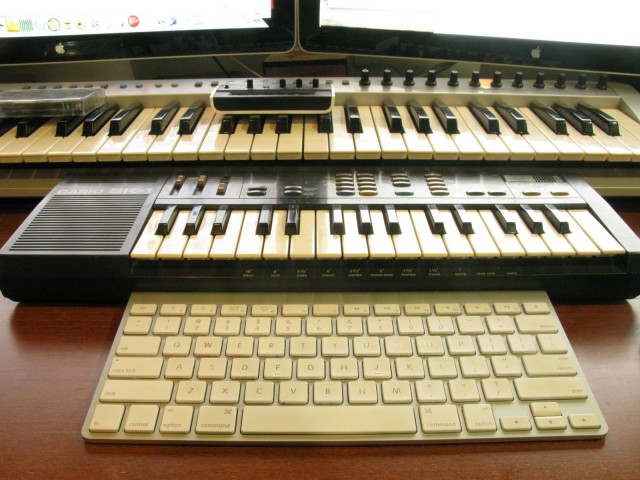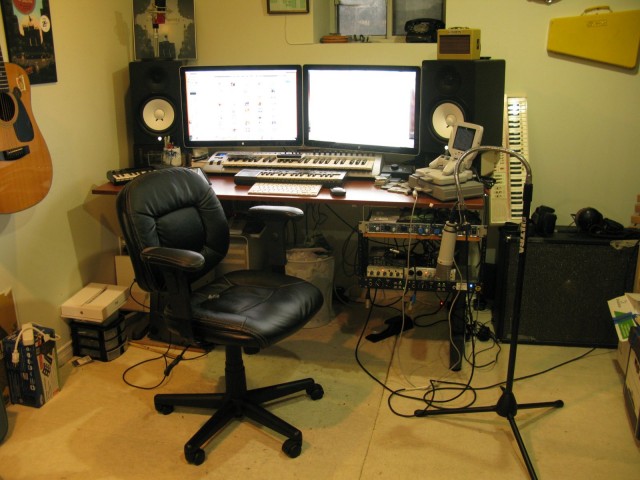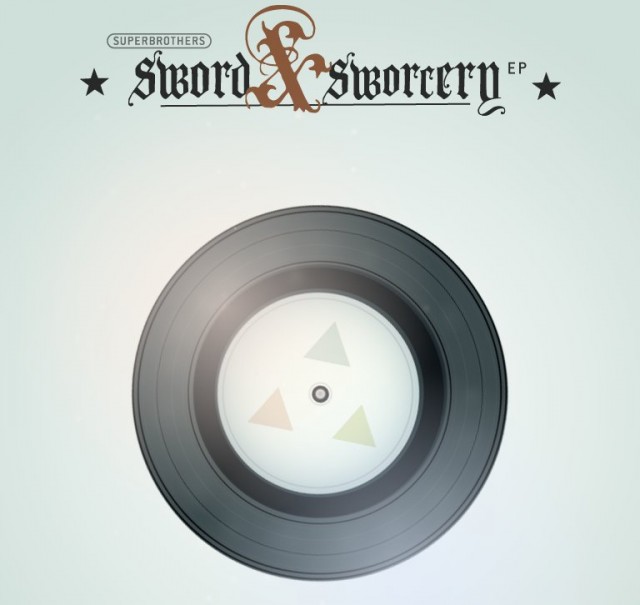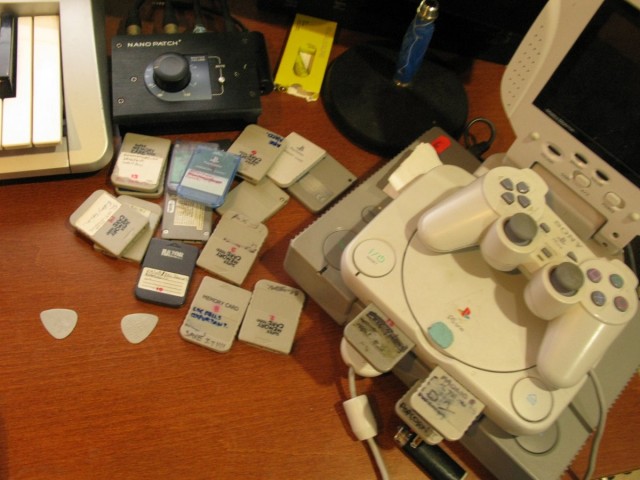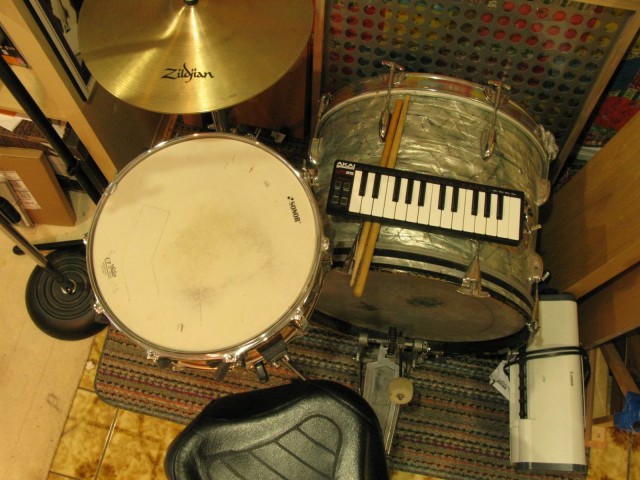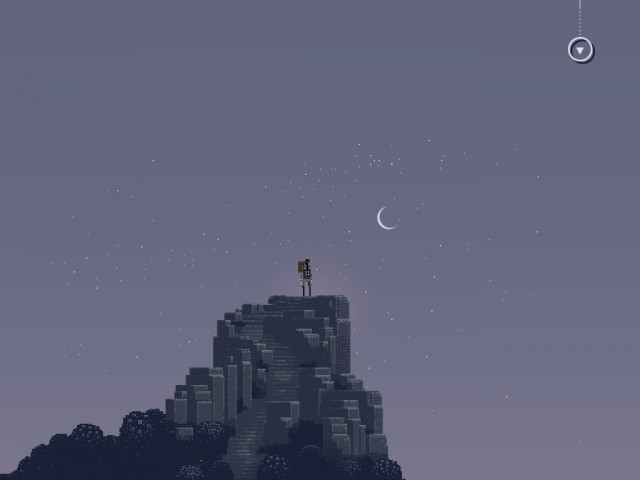Jim Guthrie was a rockstar long before the iPad was. Paired with pixel-intense artist Craig D. Adams (aka Superbrothers) and the co-design and coding effort of a crack team of video game “wizards” at the indie studio capy, he’s made a soundtrack that’s destined to be a gaming classic. But if you don’t want to play it, you can still listen to it. And if you’re playing it, you may find that it feels as though you’re listening to it, and gazing into its artwork.
From the moment you tap to launch it, Swords & Sworcery plunges you into a world that’s part game, part interactive album. Yes, there’s the obvious presence of a spinning vinyl record you can scratch and brake, right there on the title screen. And yes, there’s the conspicuous “EP” in the title, or the just-released LP (a real LP, on digital but also now sold out on vinyl).
But it’s once you navigate the expansive digital forests of the title, once Jim Guthrie’s moody soundtrack taps away at your brain, that you begin to get it. Sword & Sworcery will certainly get the dreaded (or is that coveted?) “arty” title, but it’s the way in which it spins out audiovisual entertainment that makes it special.
It’s pure aesthetic deliciousness, a brew that makes your head buzz.
And it’s finding that aesthetic sense – neither retro nor modern, neither low-fidelity nor slick – that makes this title relevant beyond even the world of gaming. Jim Guthrie’s songs and the lush pixel art graphics are the perfect fusion of old and new. It’s telling that Guthrie himself crafts his tracks in a combination of a PlayStation music game (MTV-branded, no less), GarageBand, and then high-end Universal Audio plug-ins. (See video above, and have fun gear-spotting familiar toys through the jump cuts.) It’s sort of studio garage, in the way digital music can be now. Its unabashedly synthetic instrumentation gives voice to a generation that grew up with computer-produced music. The musical score itself sometimes nods to Philip Glass, sometimes to punk rock, very often a mixed-up, intimate fantasy folk cinema, with sounds both shiny and flat.
But happily, this isn’t just a game with a clever soundtrack, or a release of game music. It’s a real fusion of album and game, music and visuals. And, lest we get to carried away with the Art label – capital a – music and game alike are good fun.
CDM managed to pry co-creators Craig D. Adams and Jim Guthrie from an adoring gaming press long enough to talk to us in depth about the making of the music and release, down to every last technical and artistic detail. They said so much – and crossed two media so completely – that I’ve broken up their ideas into two stories, across Create Digital Music and Create Digital Motion. Their reasoning for committing to those two media has a lot in common, I think, with why we run these two sites and why a lot of you read and contribute to them.
Out now: both an LP music release on Bandcamp and iPad version. Coming this month: recent-gen iPod touch and iPhone versions of the game, too.
Jim Guthrie: Sword & Sworcery LP – The Ballad of the Space Babies @ Bandcamp
http://www.swordandsworcery.com/project/
Let’s begin with the notion of this as musical-visual collaboration. Obviously, some of our favorite game experiences have used music effectively. What’s different about this project?
Craig:The iPhone & iPod Touch, and the iPad to some extent, don’t have an input style that lends itself to precise inputs. So, it seems to me that a lot of traditional video games seem to fall a bit flat on these platforms. The thing is, these machines are great music and video players, so we knew going in that we wanted to make something that was as open and as laid-back as a record-listening experience matched with a naturalistic visual presentation inspired by film, so that was really the starting point. We also felt that a more relaxed, more occasional, less punishing, more interesting experience would be a better fit, something that was closer in pace to browsing the Internet or whatever. Early on we were calling S:S&S EP “a brave experiment in Input Output Cinema.” I/O Cinema is kind of an intentionally absurd nonsense buzzword but I think it’s perfectly apt for this type of entertainment, it’s a heckuva lot more descriptive than ‘videogame’ anyways, in that it gets away from the idea of a program with rules and win/lose conditions and it puts the focus more on the conversation the audience has with the creators while the audience pokes, prods & problem-solves an authored audiovisual creation.
How did you work together, Superbrothers and Jim, to combine music and visually? What was that collaboration like?
Craig: When we looped Jim into the project in we told him the name, described the aesthetic, talked a bit about The Legend of Zelda & Castlevania, and then Jim dug around and found a few songs he thought might fit. I went ahead and tried to generate art & narrative concepts using Jim’s songs or else stand-ins to set the mood. As we started to mix things together we’d evaluate, iterate & improvise. Eventually we’d get into situations where me and Kris, Capy’s creative director and co-designer on S:S&S EP, would have a plan for an environment or a scene or a situation, and we’d get the art & the mechanics together and then pass along a rough build to Jim with some kind of suggestion like ‘go John Carpenter on this one’ or whatever, and then Jim’d work his magic, filter the concept through his music-making mind and barf up something totally beautiful & shockingly perfect. So yeah, it was a messy process, but towards the end we kind of got a feel for it, I think it all worked out super well.
Jim: It wasn’t always clear if the art needed to inspire more music or the other way around, but it was a very necessary process considering the relation the two elements share in the game.
Technically speaking, is there anything unique to the way the music integrates with game play? How did you approach the technical challenge there, in other words?
Craig: For the music integration aspect, we really just made things up as we went along. We tried some things; some of them worked, some of them didn’t. Then we’d iterate on them or revise them as necessary. We tried chopping things up into a million loops and then stringing them back together with logic, and it kind worked, but was kinda rough, so then we’d revise it or refine it. Eventually we started to figure out a bit of a groove – we learned what the limits were with the machines & the quirks of fMOD [the game sound engine]. We’re a whole lot wiser now, but I think it was a positive thing going into something like this a bit naive.
Jim: Technically, there’s nothing in this game that hasn’t been done before. We sort of ‘stood on the shoulders of giants’ and made it our own. It’s more about the mood and atmosphere that the music and art create that is special. Like Craig said, we made things up as we went.
From the beginning, we knew it was very possible that this would be released digitally as an album, but it wasn’t until a little later on that the idea of vinyl struck us as a good idea. You would think it was all planned from the beginning considering how often the image of the record appears in the game but it sort of willed itself in that direction over time.
It’s always tough to describe the process of summoning one’s art. After we had sort of figured out what the first few tracks were going to be, I just let Craig’s art and ideas lead the way and I reacted. It also really comes down to knowing your craft and what tools you use to create with. Once you figure that out the tools don’t get in the way when you’re hot on the trail of a fleeting melody. There’s noting worse than loosing that spark because a technical issue. Computers have robbed me of so many musical sparks, but to be fair, they have given it back tenfold.
I will give into the temptation to ask one obvious question – what does it mean that it’s an EP? Obviously, it’s a reference to the notion of a game release as being akin in some way to an album, but anything beyond that you wish to say?
Craig:The EP concept goes back to the start of the project – we wanted to put the sound component right out front. We wanted the whole project to feel like a musical composition, and at first we wanted to make something small and acknowledge that this was a tentative first release by a new videogame ‘band.’ The project grew from ther,e and it goes well beyond the 37 minute running-time we had originally envisioned, but everything else fits.
We had always planned to prepare a record release to accompany the project and when the time came to commit to this we basically had to make a vinyl edition, and Jim basically just put that into gear on his own… so that became Jim Guthrie’s Sword & Sworcery LP – The Ballad of the Space Babies. While the record is a smaller component of the project in terms of man-hours, the music on its own is kind of larger than the art and the story we tried to create in the actual videogame, so I think it’s kind of perfect that it’s the LP.
Jim, the music really has a quirky personality all its own, and I think it’d be too easy to describe it aesthetically. How did you approach scoring the music, in finding a voice for this title?
Craig: Several of Jim’s songs pre-date the project, so they informed the aesthetic & concepts from the start. My role early on was to translate the music into artwork & narrative that would fit the general idea of the project. But yeah, beyond that I’ll let Jim fill in the blanks here!
What’s the production process like for the music itself?
Jim: I captured all of the music either on a PlayStation using MTV’s Music Generator and/or
[Apple] GarageBand. For example, on the song, ‘Lone Star,’ I drummed a beat onto a cassette four-track, burned that onto a CD, placed the CD into the PlayStation, sampled and looped in MTV Music Generator,
and then built a song around it using that software. THEN I brought it into GarageBand and added more layers and effects. I also used a [Casio] SK-1 peppered throughout. In terms of plug-ins and soft synths, I used a lot of the Arturia stuff, [Native Instruments] Kontakt, [XLN Audio] Addictive Drums, [Toontracks] Superior Drummer, and a [Universal Audio] UAD-2 card loaded with a bunch of their processing plug-ins.
Not all games are narrative, and I’ve never found conventional narrative to be a prerequisite to art (cough, Ebert). But there is a strong narrative aspect to this title, too. How do you go about telling a story and building a game mechanic at once? (And, for that matter, do you still scrawl things on index cards to get there?)
Craig: It’s funny, we are getting some positive responses to S:S&S EP’s narrative, but really, the narrative only exists to make sense of the player’s experience; it’s not exactly ‘the point.’ We started with the songs, then the art, then the mechanics that would bring it together. And while the broad narrative concepts were always there, it was only in the final stages that the script came together, and really it’s just a way for us to help communicate what’s supposed to be going on. I was on the line to write the script, and for a good long while, it kinda sucked while I was buried under art, sound & design tasks, but I kept iterating on it, editing it for brevity, clarity, and humor, with Jim and Kris and a few others kinda guiding the process.
So yeah, I guess we did some okay things with narrative, and I’m actually super-proud of the mind-fuck tear-jerker heart-breaker finale, but I think the only reason any of it comes across is because of Jim’s music wrapped up in paintings. And really, Jim’s songs are all the narrative I ever wanted.
Now that you’ve become gaming rockstars, what’s next?
Jim: A bottle of vodka?
Craig: Hahahaha… Jim’s already a rockstar, so this stuff is probably old news. I think we’re definitely enjoying our fifteen minutes of fame in this very specific niche, and I’ve been trying – maybe too hard – to keep that buzz going so the project stays visible as we gear up for the all-important iPhone & iPod Touch launch. Once all that’s out of the way, I’m really just looking forward to some quiet time: bike rides, swimming, hiking, and whatever else.
We’ll keep the Sword & Sworcery project rolling along in the background too. We have plans for a gala event here in Toronto in a few months and some other schemes related to the app itself that’ll last the year & maybe into next year. We’ve been given a real opportunity here & we want to continue to honor that.
What are you excited about in gaming – or, for that matter, audiovisual work – at the moment, beyond your own work? Anything you’re listening to, watching, playing (or all three) at the moment?
Jim: Honestly, I went into my iTunes to have a look at my ‘Recently Played’ list and for as far as the eye could see, it’s all stuff I’m working on. No time for art! Just work!
Craig: I’ve been too busy and too exhausted to be paying much attention to what’s happening out there in videogames, film or music. To be honest, what I’m most excited about right now is the prospect of getting some fresh air and some exercise, maybe getting away from electronic screens for a bit sometime, and then after a little break maybe starting on some new creative work.
I had the opportunity to see 2001: A Space Odyssey in theaters a few months ago. I’d seen it a few times before but only on VHS… so that was a real treat, it’s an entirely different film in the theaters, there’s so much more to enjoy. I’m also a huuuge fan of Kanye West’s “Runaway.” I think that’s a genuinely incredible piece of audiovisual work; Vanessa Beecroft’s art direction really shines. Banksy’s Exit Through The Gift Shop and James Cameron’s Avatar blew me away too, for entirely different reasons. I’ve just recently seen my friend Firas Momani’s Fantasia Festival award-winning short film The Adder’s Bite & it gave me all those groovy Cronenberg + Lynch + Kubrick feelings, very inspiring.
On the video game side I’m still intermittently playing Motorstorm: Pacific Rift for PS3, a 2008 effort from Liverpool’s Evolution Studios that I think is basically perfect, plus I’m digging in to Monster Hunter Tri on Wii. I’m playing Monster Hunter co-operatively with a couple friends every Sunday morning… we’re still just scratching the surface but it’s easily the most intricate and deep video game I’ve ever played, which takes me way outside of my comfort zone in an interesting way. I’m also cautiously optimistic about L.A. Noire, Uncharted 3, and The Last Guardian… we’ll see how they work out in the end.
On the music side, I’ve been listening to Jim’s Sword & Sworcery LP… even though I’ve heard these tunes so much in the last two years that my ears hurt, the record itself still comes across as beautiful & fresh, the songs still evoke all kinds of imaginings. That record aside I’ve got a heckuva lot of catching up to do… but first I have to give my ears a bit of a break. That said, I’m amped for the Beastie Boys record that’s hitting in the next little while.
All images courtesy Superbrothers and Jim Guthrie. Used with permission.
Do let us know what you think of the game, folks – or whatever audiovisual creations, in the form of games or otherwise, inspire you.
More on the art, the design, the coding – and why Superbrothers went iOS-only.
On our sister site:
Inside Handheld Game Art: The Art Style and Making of Swords & Sworcery, Superbrothers Pixel Cinema [Create Digital Motion]
And, oh yeah, don’t forget to get the game:
http://www.swordandsworcery.com/

